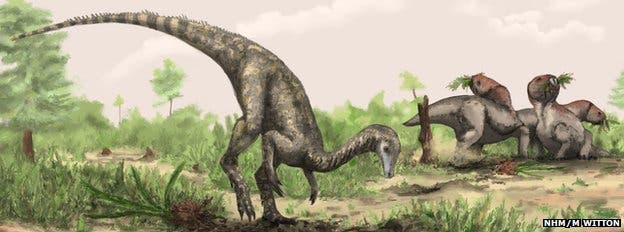Nyasasaurus parringtoni may have not been revered by other dinosaurs, but according to a new study published in Biology Letters, he is the oldest dinosaur to walk the face of the Earth, surpassing the previous record holder by 10-15 million years.
It walked on two legs, measured 2-3 m in length, had a large tail and weighed between 20 and 60 kg. The study is not only important for the species itself, but also because it shows a great amount of time passed between the dinosaurs’ emergence and their established dominance on land.
“It fills a gap between what we previously knew to be the oldest dinosaurs and their other closest relatives,” report co-author Paul Barrett, of the Natural History Museum in London, explained. “There was this big gap in the fossil record where dinosaurs should’ve been present and this fossil neatly fills that gap.”
The early evolution of dinosaurs is extremely difficult to figure out because a huge number of different reptiles were emerging at the time – some which independently developed dinosaur-like characteristics. However, despite not finding a full skeleton, and still missing one upper arm bone and six vertebrae, the team seems quite certain they have a dinosaurs on their hands, with unambiguously dinosaur-like features, including an “elongated deltopectoral crest” that served as an anchor for strong pectoral muscles – a feature specific only to dinosaurs.
The lead author of the study, Sterling Nesbitt, of the University of Washington Seattle, also led a study in 2010 which reported the finding of the dinosaurs’ oldest relative, a member of a group called the silesaurs. Apparently, silesaurs shared their territories with N parringtoni.

The study indicates that dinosaurs emerged in the southern parts of the supercontinent Pangaea
“Those animals were the earliest of this group that led up toward dinosaurs,” explained Dr Barrett. “Now this takes dinosaurs back to the right kind of time when those two groups would have split apart from each other.”
The finding closes an evolutionary gap, showing that dinosaurs did not start out as dominant, but established their dominance in millions of years.
“We push the origin of dinosaurs further back in time to a time when lots of reptile groups are evolving,” Dr Barrett said. Dinosaurs start out as a very insignificant group of reptiles – all relatively small animals, relatively rare in comparison with other reptile groups – and it’s only a bit later in their history that they suddenly explode and take over as the dominant forms of life for nearly 100 million years.
Pictures via BBC










